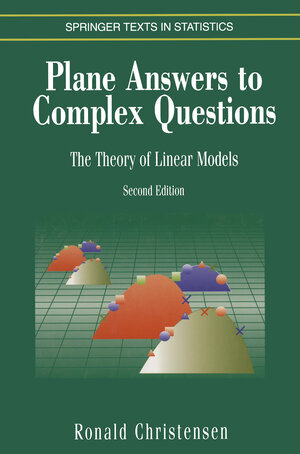
From the reviews of the third edition:
„This well-written and interesting book can serve as a textbook for a graduate-level course in linear model theory and its applications, and as a reference book for a wide range of definitions and results associated with particular linear models.“ Journal of the American Statistical Assoc.
"The following quotations are taken from the (same) reviewer's comments on the second edition (Short Book Reviews, Vol.17/1, April 1997, p.4): The book „retains its fairly mathematical character... The writing style is inviting... friendly and affable... The computing aspects of regression are de-emphasized and the text leans more towards well-prepared students.“ All are still true, and I once again recommend the book for the indicated target audience.„ ISI Short Book Reviews, Vol. 22/3, 2002
“This book with the unusual title has been quite popular because of its lucid treatment. What I like most about the book is that many important observations have been made in an entertaining manner. … In this edition the idea of identifiability has rightly been given more emphasis than estimability, which sets this book apart from most other books on linear models. … I have always regarded this book as a must-read for serious users of linear models. The third edition makes it even better.” (Debasis Sengupta, Sankhya, Vol. 65 (4), 2003)
„This is the third edition of a popular textbook in general linear models aimed at graduate students. … The appealing features of this book lie in its projection-based dogma and its thought-provoking conversational prose. It continues to serve as an authoritative, well-written, polished linear models text that is useful both as a reference and as a graduate course text.“ (Robert Lund, Journal of the American Statistical Association, Vol. 98 (463), September, 2003)
„The book ‘retains its fairly mathematical character. The writing style is inviting, friendly and affable. The computing aspects of regression are de-emphasized and the text leans more towards well-prepared students.’ All are still true, and I once again recommend the book for the indicated target audience.“ (N. R. Draper, Short Book Reviews, Vol. 22 (3), 2002)
„This 3rd edition, like the preceding editions, illustrates the practical applications of projective approach to linear models. … elegant treatment of identifiability and estimability and their connection. … Excellent examples are used to illustrate the effect of high leverage. … The intended audience for this book appears to be first-year graduate students. … I feel that Plane Answers to Complex Questions is a nice addition to the literature on linear models. … excellent references for practitioners.“ (Felix Famoye, Technometrics, Vol. 45 (2), May, 2003)



